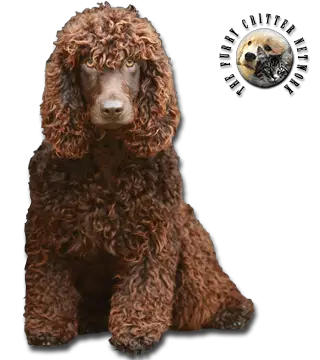Breed Standard
Head: Large but long. Domed skull covered with long curls forming a topknot. Gradual stop. Long, strong, angular muzzle. Dark liver nose.
Ears: Set on low, very long, hanging against the cheeks, covered with long curls.
Eyes: Medium to dark brown.
Body: Compact. Sturdy, fairly long neck. Broad chest. Ribs set well back. Short, broad back. Deep, broad loin.
Tail: Set on low, short, straight, thick at the base and tapering toward the tip. Carried straight, below the topline. A well-defined band extending 8 to 10 cm from the base must be covered with tight curls. The rest of the tail is hairless or covered with fine, straight hair.
Hair: Thick, tight, crisp curls. Oily hair. Feathering on the legs.
Coat: Dark liver with a bluish or velvety cast specific to the breed and sometimes called "puce".
Size: Dog: 53 to 58 cm (21-22.8 in). Bitch: 51 to 56 cm (20-22 in).
Weight: 22 to 26 kg (28.5-57.5 lb).
History
Although the current breed stock is Irish, the origin of the breed, The Irish Water Spaniel is a native Irish breed for over 1000 years. It is believed in Irish folklore to be the descendant of the Dobhar-chu. It is probable that more than one ancient breed of spaniel has gone into its makeup. It is not known from which other breeds Irish Water Spaniels were developed. The acknowledged father of the breed, Justin McCarthy from Dublin, left no breeding records. All manner of dogs have been suggested including: the Poodle, Portuguese Water Dog, Barbet, generic old water dog, the now-extinct English Water Spaniel as well as the Northern and Southern Water Spaniels, but whether Irish Water Spaniels are antecedents, descendants, or mixtures of these other breeds is a matter of some speculation. What is clear is that the breed has ancient roots. The modern breed as we know it was developed in Ireland in the 1830s.
Behavior
Irish Water Spaniels may make good family dogs, as they are usually excellent with respectful children and with other pets. They can make good guard dogs if they have been trained to do so, and will protect their human families. Not usually an aggressive dog, yet the IWS may have a deep, fierce-sounding bark.
Dynamic, active, enthusiastic, and tenacious, the Irish Water Spaniel has great endurance and a very discerning nose. He specializes in wild birds (including duck). He is a good flusher and well-adapted to working in the water. His search is hard-driving and quick, and he is silent on the trail. Adorable and courageous, according to some, he is often difficult. He needs firm training.
He needs wide open spaces and lots of exercise, as well as combing twice weekly and regular checking of the ears.
Function
Hunting Dog, Pet.
Health
All Irish Water Spaniels require a grooming regimen that includes maintaining healthy ears, teeth and nails. The tight double coat of the IWS sheds slightly, however many allergy sufferers have found them to be a comfortable pet with which to live. The texture of the hair prevents the coat from becoming tightly woven into fabric and upholstery and any stray hairs are easily removed as they will gather together to form "dust bunnies". The coat can be maintained by even the novice owner if a regular effort is maintained to keep it clean and free of mats. A thorough combing to the skin should take place every 1–2 weeks to promote healthy skin and to remove any objects from the coat. Scissoring will be required every 6–8 weeks to neaten and shape the coat while regular exposure to water will promote the correct "ringlets" over the body coat.
The breed is prone to hip dysplasia, hypothyroidism, eye entropion and ear infections.






